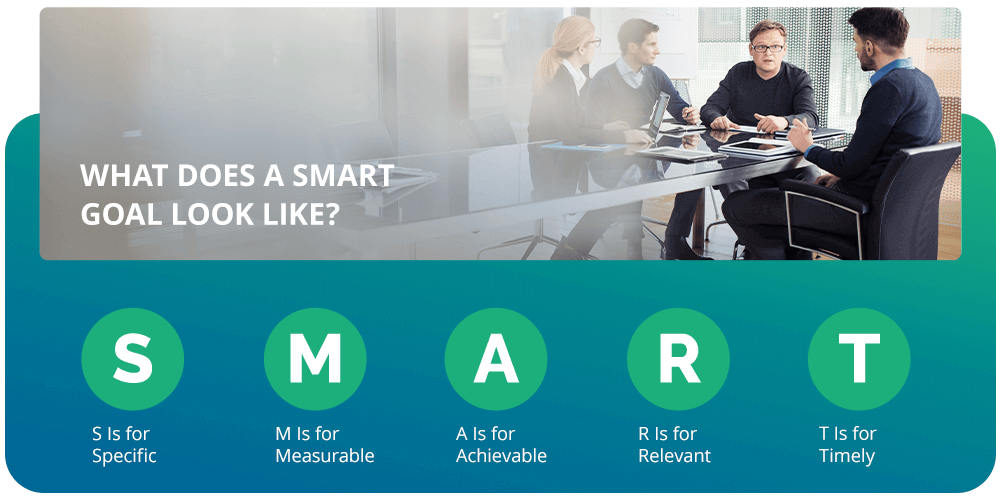Since the beginning of time, humans have been ambitious. From building pyramids to writing the Odyssey, humans love making goals and getting things done. Today, we have the SMART goals methodology to help us make valuable goals and reach them more often.
SMART goals were outlined back in 1981 by George T. Doran, who noticed that many business goals were too diffuse to have a meaningful impact. He wrote about how goals are not amorphous and inarticulate but measurable and must be achieved if the organization wants to move forward. He created the SMART goals methodology to create meaningful, valuable goals. Since then, the concept has been slightly tweaked into the SMART criteria we know and love today.
In This Article
- What Are SMART Goals?
- So, What Does a SMART Goal Look Like?
- Questions to Ask to Ensure Your Goals Are SMART
- How to Make Your SMART Goals Even Smarter
- SMART Goal Examples
- 5 Tips for Executing SMART Goals
- Using AchieveIt to Make, Meet and Exceed Your SMART Goals
What Are SMART Goals?
SMART goals are well-defined goals that follow a specific structure to support the goal-setter’s achievement. Each element helps set you up for success, following the letters in the SMART goals acronym. The “SMART” in a SMART goal stands for Specific, Measurable, Achievable, Relevant, and Timely. With each of these components, teams and individuals can improve their chances of success.

So, What Does a SMART Goal Look Like?

SMART goals can cover almost any topic, from personal goals like running a marathon to professional goals like focusing on career development or achieving certain key performance indicators (KPIs). The key element of a SMART goal is it fits into a specific framework. The SMART framework breaks a goal down into different parts to set you up for success, with each letter in the SMART goals acronym referring to a different characteristic of the goal.

S Is for Specific
Making a goal specific is key to getting it done. If your goal is too vague, you and your team will be sliding off the rails trying to stay on track. Specificity is your shining beacon, the factor that guides your progress.
Instead of just saying you want to increase sales, drill down. Are you trying to improve your channel partner business? Do you want your senior account executives to have different goals than your junior folks? Great! Get specific and write it out.
M Is for Measurable
You know what you want to do — now it’s time to identify how you’ll know you’ve been successful. Define what success looks like in your goal through quantifiable measurements. Words like increase, decrease, or maintain can put you firmly in measurable territory. If you say you want to increase channel partner sales by 20%, you can move that number up or down or keep it the same as you progress. By making your goal measurable, you can see the changes clear as day, with each movement giving you valuable insights about reaching your SMART goal.
A Is for Achievable
A goal needs to be realistic. Research tells us that goals have a sweet spot — not too hard, not too easy, and just challenging enough. Setting a goal should be challenging enough to require significant effort on your part, but not so hard that it is unattainable. Easy or “do your best” goals aren’t as effective as specific ones.
To find that sweet spot, try looking at historical information or the success of people in similar positions. If your sales typically grow by 20% annually, why not shoot for 25% this year? If other representatives have increased their customer satisfaction scores by 10 points, you probably can, too.
Get out of your comfort zone and shoot for the stars — just be sure that you’re not shooting for a star in a completely different galaxy.
While we’re on the subject, the topic of achieving goals is something our team is familiar with. Our appropriately named platform AchieveIt is designed to help you align business goals, including SMART goals, with your business plan. After establishing your goals, this will be the most important step in achieving your goals.
R Is for Relevant
Goals are great, but they must be worthwhile. For example, it might not be helpful to increase the number of students who sign up for emails if students rarely convert to paying customers. For businesses, making relevant goals that align with other organizational goals is critical.
It’s worth noting that some people say the “R” in SMART goals stands for “realistic,” but that’s pretty similar to “achievable,” so we prefer the less redundant approach. Relevancy is far better for keeping SMART goals on track and aligning them with business goals.
T Is for Timely
Deadlines can motivate you to get something done. Sometimes they’re stressful, but they’re often necessary, too. Setting SMART goals is one of the necessary times. Sometimes the deadline is set for you — “my boss wants me to improve my leadership skills by the end of the quarter” — in which case, it’s easy to make the timeframe for your SMART goal. Other times, you’ll have to do it yourself.
Quarterly goals are often a good place to start because they offer enough time to make an action plan but not so much time that you lose all sense of urgency.
Questions to Ask to Ensure Your Goals Are SMART
A great way to make sure you’re setting SMART goals is to run through some questions for each part of the SMART goals acronym. When determining how SMART your goal is, ask yourself the following questions:
- Specific: What do I want to accomplish? Why do I want to accomplish it? Who is involved in accomplishing this goal?
- Measurable: How will I know that this goal has been accomplished? What are the key lagging and leading indicators for the success of this goal? Can progress for this goal be reasonably measured?
- Achievable: What will it take to accomplish this goal? Given all time, capacity, and resource constraints, how realistic is the achievement of this goal? Has this been successfully accomplished before?
- Relevant: Does this goal align with higher-level organizational goals and objectives? Will the investment in accomplishing this goal be worthwhile? Do we have the proper people and resources to accomplish this goal?
- Timely: When do I want the work on this goal to begin? By when do I want this goal to be accomplished? Have all dependencies been considered?
Throughout the process, consider what you’ll use to create SMART goals. What information will guide your goal statement? You might use previously tracked KPIs or your organization’s vision. Get a broad overview of your resources to ensure a data-driven SMART goal.
How to Make Your SMART Goals Even Smarter
While setting SMART goals is an excellent start, you can go further and boost your chances at success. Try using these three strategies to make your SMART goals smarter and improve the execution process.

Create Alignment
Many people use “alignment” as a buzzword, but here, it just means ensuring your SMART goal matches higher-level goals for your organization and department. The business has a purpose, and SMART goals should propel it toward that purpose.
One tricky aspect of alignment is this shared purpose is a prerequisite for aligned SMART goals. If your organization doesn’t have a clear, defined direction, results will be harder to come by. And many people think their companies are more aligned than they really are.
Researchers have compared general ratings of alignment with written statements. They found that most workers, including frontline employees, middle managers, and senior executives — rated strategic alignment at about 82%, but the real level was just 23%. The organizations with the highest gap between the two values had slower and lower-quality implementations.
Take a good, hard look at your company’s alignment to avoid being one of these businesses. Set goals that align with larger business needs and strategic objectives. These elements can drive executive support and funding and foster success. Aligning SMART goals will enable everyone in the organization to understand how they support the organizational goals.
Track Your Progress — In Simple Terms
Developing and planning goals can be exciting and offer plenty of motivation. Next comes the execution phase, where it’s easy to lose momentum. It’s usually the most challenging part of achieving a goal, as team members often lose steam when other tasks get in the way. The key to keeping momentum is to track your progress simply and effectively. Without tracking in place, creating SMART goals is a lost cause.
Effective tracking allows you to gauge your progress toward goals and create a streamlined reporting process. A simple tracking and reporting process should, for instance, be free of convoluted systems, multiple spreadsheets, or excessive KPIs. With a simple tracking and reporting process, you can more easily reduce failures and maintain focus.
The AchieveIt platform, for example, works as a single source of truth. It keeps your tracked data centralized in one place for simple yet effective monitoring of all your quantified information. It collects updates, compiles reports, and builds customized dashboards for ongoing tracking and analysis. Maintain focus and motivation by keeping your goal top of mind as you work toward it.
Ensure Visibility
Visibility is crucial for both teams and solo workers to achieve goals. By making your progress highly visible and offering access to everyone involved, you remove barriers to execution and support timely conversations. Everyone stays on the same page, and you can better identify opportunities for success. Alongside your progress tracking, you can monitor other elements related to your SMART goal, such as task assignments, updates, and conversations.

The best way to ensure visibility is to funnel your updates into effective reports through a streamlined process. Simple, clear reporting allows you to monitor SMART goals continuously and enable quick decisions throughout the project timeline. You can pivot your strategy as the project demands and keep your eyes on the bigger picture.
SMART Goal Examples
Now that you know what goes into setting a SMART goal, let’s explore what one looks like with SMART goal examples. SMART goals should be outlined in a comprehensive mission statement that includes all components of the “SMART” acronym.

Your mission statement should start with your quantifiable, specific goal and your deadline: “We aim to increase social media leads by 15% by the end of Q3.” You can also mention the relevance of the goal: “Social media leads typically convert well for us.” Briefly outline who will achieve the goal and how: “The social team will create new campaigns targeting audience engagement and video.”
With that basic outline in hand, let’s look at some examples of SMART goals in action.
1. Increasing Mobile Shopping App Usage
A marketing manager for an e-commerce store has been tasked with increasing the usage of a mobile shopping app. She develops her SMART goal to be:
- Specific: The social media team will start a new campaign to increase app downloads and usage.
- Measurable: The manager’s goal is to increase the number of users by 20%.
- Achievable: Based on her team’s capability and its success with a similar goal a few months ago, she determines that the goal is achievable.
- Relevant: Mobile users tend to make more purchases from the online store, lining up with the company’s current goal of targeting more profitable audiences.
- Timely: The manager wants to reach this 20% increase by the end of the next quarter.
2. Raising the Average Sale Amount
The sales manager of a small furniture store decides he wants to help his team improve their average sale amount by developing skills for add-on sales, such as protection plans, installations, and accessories. To do so, he creates a SMART goal that is:
- Specific: To increase the average sale amount, workers will take required training modules, role-play mock scenarios, and celebrate add-on sales.
- Measurable: The sales manager sets a goal to improve the average sale amount by $300.
- Achievable: He determines this number is attainable yet challenging based on numbers from other stores in his district.
- Relevant: The store is currently focused on promoting its services, so additional protection plans and installations align with that goal. More sales also help with profits and allow team members to make more commission.
- Timely: Within three months, the sales manager wants his team to meet the goal.
3. Improving Communication
A contractor has received feedback that he has poor communication with his team. Here’s the SMART goal example for his situation:
- Specific: He plans to improve communication by holding biweekly check-ins with every team member. He also thinks he can keep everyone on the same page and boost visibility by posting project updates where all workers can see them.
- Measurable: The contracting company regularly conducts pulse surveys, and this contractor will be looking to increase the number of employees who say he communicates well by 30%.
- Achievable: The contractor has a relatively small team, so he has time to conduct his brief check-ins, and a 30% increase in positive responses is viable.
- Relevant: The company focuses on improving employee satisfaction, and communicative leaders can help it meet those goals.
- Timely: Pulse surveys occur twice a year, so he wants to meet this goal by the time the next one is conducted.
4. Getting More Leads
An admissions team for a large college wants to increase the number of students applying for the school’s new engineering program. To get there, they create a SMART goal for generating more leads with the following factors in mind:
- Specific: The team decides to increase the number of students who sign up for the program’s email list by increasing outreach efforts, such as attending career fairs and engineering-focused events and sending out mailers to prospective students.
- Measurable: They decide on a goal of receiving 500 more leads than they had last year.
- Achievable: The team has enough staff to send to events and already has mailers ready to go, so they feel the goal is attainable.
- Relevant: One of the school’s goals for the upcoming year is to increase applications for the engineering program, so generating more leads aligns with that goal.
- Timely: The team’s deadline is the end of the application period.
5. Reducing Staff Turnover
A manufacturer has been dealing with high turnover rates on the shop floor. To fix it, the HR manager implements a SMART goal that is:
- Specific: She sets up a multi-pronged approach to reducing staff turnover that includes learning more about why people are leaving through exit surveys, increasing leadership skills training for management, and boosting morale with an employee recognition program.
- Measurable: The manager aims to decrease the turnover rate to 45%.
- Achievable: Considering that her company’s current turnover rate is 55% and the average turnover rate for the industry is about 40%, she thinks this goal is achievable.
- Relevant: A lower turnover rate can save on hiring and training costs to help the company hit its profit goals for the year.
- Timely: The HR manager gives herself six months to meet her goal.
6. Boosting Blog Traffic
Say a small consulting firm wants to increase blog traffic from technical professionals in the industry. The marketing team takes on the task with a SMART goal:
- Specific: The team decides to focus on organic results from online searches. They will work on their search engine optimization (SEO) strategy by taking courses and creating a set of technical blog posts and whitepapers.
- Measurable: They aim to increase organic growth by 30%.
- Achievable: The company has a large enough marketing team and a flexible workload that allows them to tackle the new pieces.
- Relevant: More traffic from technical professionals will likely generate more high-quality leads.
- Timely: The team sets a goal for the end of the next quarter.
5 Tips for Executing SMART Goals
Setting SMART goals is one thing, but executing them is another. Below are some tips on how to write SMART goals and make sure they happen.
1. Share Your Goals With Stakeholders and Team Members
Sharing your goals with others can keep you accountable, and if you’re working on a team-wide goal, it’s essential to keep everyone on track and on the same page. Use a work management tool as your central source of truth for reaching your goals. You can connect with others more often and easily see what everyone is up to.

2. Regularly Check Progress
Monitor your progress often. If your goal is a point on a map, progress checks are mile markers. If you suddenly notice the numbers going in the wrong direction, you know you need to change course. Consider creating weekly project updates where you highlight milestones and wins and discuss any changes or focus areas that might be needed.
3. Evaluate Your Achievements
If you met your goal, stop and celebrate! Then, look at the entire project and review what went right and what might have held you back. If you didn’t reach your goal, you can evaluate your progress to see what could have helped you reach it. Regular check-ins can help you record progress so you can more easily review your goals after the deadline.

4. Split the Goal Into Smaller Parts
Your SMART goal should be specific, but if it still seems a little daunting, try breaking it down into smaller, more easily achievable tasks.
5. Establish a Support System
Whether you’re working solo or with a team, make sure you have a support system in place. If someone is struggling with a task, they should be able to talk to their teammates, who can help with the task or boost morale.

Using AchieveIt to Make, Meet, and Exceed Your SMART Goals
Now that you know what SMART goals look like, how to write SMART goals, and how to make them even smarter, you’re almost ready to go forth and achieve! The last thing you’ll need is a tool built for helping businesses achieve their SMART goals. AchieveIt is a platform organizations use to turn their biggest, best initiatives into reality. It helps ensure that your great ideas don’t fizzle out because of a lack of focus or clarity. AchieveIt supports businesses in meeting their goals by:
- Putting everything in view, so you can see what’s happening with every initiative, at every level, in real-time.
- Getting everyone engaged with an easy-to-use interface that connects the entire organization, from executives to project teams, to keep everyone accountable and on the same page.
- Enabling every possible advantage through a premier platform and our expertise on goal execution.

From global corporations to federal agencies and regional healthcare systems, many organizations have become success stories for using AchieveIt for integrated plan management solutions. Learn more about the platform online or reach out to us for a free demo to see AchieveIt in action. Let’s actually do this.



